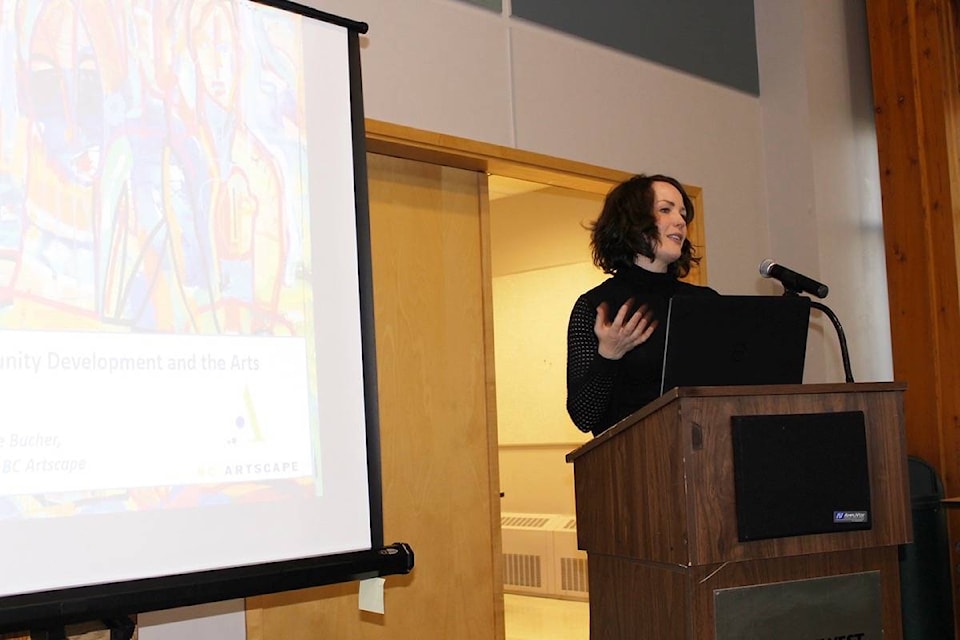Creative minds and innovators of artistic work in Prince Rupert have never had a shortage of inspiration to draw from on the North Coast of British Columbia. The natural beauty has always been there. It’s capitalizing on the potential hotbed of visual artists, performing artists, carvers, sculptors and more, which is the current conundrum for the city.
Places like Santa Fe, New Mexico, a community right in the middle of the desert, was pointed to by Marleen Morris, co-director with Community Development Institute (CDI) at the University of Northern British Columbia (UNBC) last week as a prime example of what could be.
“For years, it has been home to a very vibrant music scene and a very vibrant theatre scene,” she said.
The goal, for Prince Rupert, is to become the next Santa Fe, or Wells, B.C., or Stratford, Ontario.
“Imagine if we in Prince Rupert were able to host workshops that featured our world-renowned artists from this region – some of them carvers, some of them cultural artists – and bring people from all over the world to visit Prince Rupert,” Morris continued.
That’s the endgame. Getting from A to B is the hard part.
That’s why Morris and the Redesign Rupert team brought Genevieve Bucher, president at the non-profit BC Artscape, member of the board of Canada’s oldest artist-run centre Western Front, co-chair of the BC Urban Land Institute’s Engagement Committee, and former senior planner with the City of Vancouver, to Prince Rupert for a Community Development and the Arts CDI Speaker Series segment last Thursday at UNBC Northwest Campus. Bucher’s work has centred around leveraging available community space assets and transforming them into affordable social and creative spaces for the arts scene.
“We create the conditions for artists and creative communities to thrive by developing and managing affordable space, programs and services. Our real intention is to generate positive cultural, economic, socioeconomic and environmental impacts and outcomes through the space projects,” Bucher said.
BC Artscape has three projects on the go at the moment — two in Vancouver and one in Surrey. The two-member team has reached their capacity for current projects, but offer a mentorship and coaching program for smaller organizations that approach them with cultural space projects all over the province.
“What we have learned is that the community is very interested in growing the [arts] sector and looking at space to grow the sector. We have heard from many that there is a lack of space, a lack of studio space, rehearsal space and performance space. So we looked at bringing in someone who could speak to arts and culture as an economic driver and someone who could provide expertise on creating the kind of space that would serve as a hub or the heart of an arts and culture sector in the community,” said Morris.
Central to Bucher’s presentation was the impact that the arts and culture scene can bring to the Rupert economy. Province-wide, Bucher said that StatsCan numbers show that the B.C. cultural industries’ direct contribution to the province’s economy was $7.2 billion in 2014, 87,800 jobs directly related to cultural industries, with the GDP of the industry larger than that of agriculture, forestry, fishing and hunting put together. It also adds seven times that of the sports industry to the B.C. economy.
“It’s no small player in the province’s industry,” she said.
Through her research, Bucher has learned that there are a few ways of capturing just what the value of arts and culture is to a community, but for some countries that have tried to learn, like the U.S., Australia and the U.K., she has found that for every dollar spent on the arts, between $18 to $27 is seen as a social return on investment. At the municipal level, every dollar spent generates between $7 and $13 of economic activity.
Prince Rupert Mayor Lee Brain and Laurie Gray, president of the Prince Rupert Community Arts Council, called their residents to action by asking all to get involved any way they can.
“Every organization is always capped for capacity. Volunteer burnout is rampant and so one of the things we try to do is identify key places together,” said Brain, referencing the old CN building at the waterfront and McKay Street Park as projects that are both on the city’s radar to be revitalized.
“We need these spaces where we can come together to talk more and just have more dialogue, and have professionals who know and have experience, and have models that we can draw from.”
Members of the audience expressed their dismay at the loss of the Ice House Gallery, which will need to find a new place to set up shop when its lease expires this fall at Atlin Terminal in Cow Bay.
Gray emphasized the need for space even more when she told of her experience in Vancouver’s art gallery. Every time she goes, she has a deep emotional reaction and it’s because of the dedicated space that the works of art have, and are shared with everyone.
“It’s the value that it is a beautiful building and the art is valued. It’s not in a basement. It’s not hidden away. It’s a beautiful building given to art,” Gray said.
“I invite you to be involved. I invite you to invest your time and energy and for your groups, that you all represent, to bring something forward, and you’ll get small little towns like Wells and the Banff Centre. All these great things — they started somewhere, so our great thing is starting tonight.”
